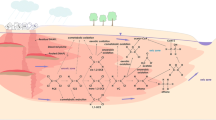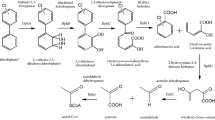Abstract
The environment has become polluted with a variety of xenobiotics, including PCBs, as a result of the industrial development of useful halogenated compounds. While the PCBs may not exhibit the acute toxicity originally ascribed to them, they and their attendant byproducts remain as significant factors for adverse effects in the ecological food-chain. The use of microorganisms for bioremediation of PCBs is reviewed. This paper further details three new isolates obtained by conventional enrichment technics which show significant degradation capabilities for Aroclor 1242. These were identified by morphology, staining, and fatty acid analysis as Comamonas testosteroni, Rhodococcus rhodochrous, and a strain of Pseudomonas putida. These isolates demonstrated somewhat selective degradations of the congeners within Aroclor 1242; comprising total losses of 13.8, 19.1, and 24.6%, respectively. Each organism can attack dichloro-through tetrachlorobiphenyls. Analysis of chromatographic patterns from anaerobically digested Aroclor 1242 samples treated by these bacteria demonstrated decreases in di- through penta-substituted biphenyls. Each of these isolates, with discrete specificities, showed preferences for ‘open’ 2,3-sites, indicative of the action of 2,3-dioxygenase enzymes. The identification of many intermediates in the foregoing transformations was established by GC-MS analyses. Several variations in metabolic pathways, centering on the meta cleavage product 2-hydroxy-6-oxo-6-phenylhexa-2,4-dienoic acid (HOPDA) were suggested from these data. It is concluded that the described strains may be of future bioremediation use in processes which have an initial anaerobic dechlorination stage.
Similar content being viewed by others
References
Abramowicz DA (1990) Aerobic and anaerobic biodegradation of PCBs: a review. Crit. Revs. Biotechnol. 10: 241–251
Adams RH, Huang CM, Higson FK, Brenner V & Focht DD (1992) Construction of a 3-chlorobiphenyl-utilizing recombinant from an intergeneric mating. Appl. Environm. Microbiol. 58: 647–654
Adriaens P & Focht DD (1990) Continuous coculture degradation of selected PCB congeners by Acinetobacter spp. in an aerobic reactor system. Environ. Sci. Technol. 24: 1042–1049
Ahmed M, Focht DD (1973) Degradation of polychlorinated biphenyls by two species of Achromobacter. Can. J. Microbiol. 19: 47–52
Bedard DL (1990) Bacterial transformations of polychlorinated biphenyls. In: Kamely D (Ed) Biotechnology and Biodegradation (pp 369–391). Gulf Publ. Co., Houston
Bedard DL, Haberl ML, May RJ & Brennan MJ (1987a) Extensive degradation of Aroclors and environmentally transformed polychlorinated biphenyls by Alcaligenes eutrophus H850. Appl. Environ. Microbiol. 53: 1094–1102
Bedard DL, Haberl ML, May RJ & Brennan MJ (1987b) Evidence for novel mechanism of polychlorinated biphenyl metabolism in Alcaligenes eutrophus H850. Appl. Environ. Microbiol. 53: 1103–1112
Baker ME (1990) Sequence similarity between Pseudomonas dihydrodiol dehydrogenase, part of the gene cluster that metabolizes PCBs and dehydrogenases involved in the metabolism of ribitol, glucitol, and the synthesis of antibiotics and 17-β-estradiol, testosterone and corticosterone. Biochem. J. 267: 839–841
Borlakoglu JT, Welch VA, Wilkins JPG & Dils RR (1990) Transport and cellular uptake of PCBs I, II. Biochem. Pharmacol. 40: 265–272; 273–281
Bosma TNP, Van der Meer JR, Schraa G, Tros ME & Zehnder AJB (1988) Reductive dechlorination of all trichloro- and dichlorobenzene isomers. FEMS Microbiol. Ecol. 53: 223–229
BrownJr. JF, Wagner RE, Bedard DL, Brennan MJ, Carnahan JC, May RJ & Tofflemire TJ (1984) PCB transformations in the upper Hudson sediments. Northeast Environ. Sci. 3: 167–179
BrownJr. JF, Wagner RE, Feng H, Bedard DL, Brennan MJ, Carnahan JC & May RJ (1987) Environmental dechlorination of PCBs. Environ. Toxicol. Chem. 6: 579–593
Brunelle DJ, Mendiratta AK & Singleton DA (1985) Reaction/removal of PCBs from transformer oil: treatment of contaminated oil with polyethylene glycol/KOH. Environ. Sci. Technol. 19: 740–745
Brunstrom B (1989) Toxicity of coplanar polychlorinated biphenyls in avian embryos. Chemosphere 19: 765–768
Buff K & Brundl A (1992) Specific binding of PCBs to rat liver cytosol protein. Biochem. Pharmacol. 43: 965–970
Catelani D, Colombi A, Sorlini C & Treccani V (1973) Metabolism of biphenyl-2-hydroxy-6-oxo-6-phenylhexa-2,4-dienoate: the meta-cleavage product from 2,3-dihydroxybiphenyl by Pseudomonas putidd. Biochem. J. 134: 1063–1066
Chakrabarty AM (1986) Genetic engineering and problems of environmental pollution. In: Rehn HJ (Ed) Biotechnology, Vol 8 (pp 516–530). VCH Publishers, New York
Chaudhry GR & Chapalamadugu S (1991) Biodegradation of halogenated organic compounds. Microbiol. Revs. 55: 59–79
Chen M, Hong CS, Bush B & Rhee G-Y (1988) Anaerobic degradation of polychlorinated biphenyls by bacteria from Hudson River sediments. Ecotoxicol. Environ. Safety 16: 95–105
Criddle CS, Dewitt JR, Grbic-Galic D & McCarty PL (1990) Transformation of carbon tetrachloride by Pseudomonas sp. KC under denitrification conditions. Appl. Environ. Microbiol. 56: 3240–3246
Erickson MD (1985) Analytical Chemistry of PCBs. Butterworths, Stoneham, Massachusetts
Fathepure BZ & Vogel TM (1991) Complete degradation of polychlorinated hydrocarbons by a two-stage biofilm reactor. Appl Environ. Microbiol. 57: 3418–3422
Fuchs K, Schreiner A & Lingens F (1991) Degradation of 2-methylaniline and chlorinated isomers of 2-methylaniline by Rhodococcus rhodochrous strain CTM. J. Gen'l. Microbiol. 137: 2033–2039
Furukawa K & Chakrabarty AM (1982) Involvement of plasmids in total degradation of chlorinated biphenyls. Appl Environ Microbiol. 44: 619–626
Furukawa K & Suzuki H (1988) Gene manipulation of catabolic activities for production of intermediates of various biphenyl compounds. Appl. Microbiol. Biotechnol. 29: 363–369
Furukawa K, Tonomura K & Kamibayashi A (1978) Effect of chlorine substitution on the biodegradability of polychlorinated biphenyls. Appl. Environ. Microbiol. 35: 223–227
Furukawa K, Tonomura K, & Kamibayashi A (1979) Effect of chlorine substitution on the bacterial metabolism of various polychlorinated biphenyls. Appl. Environ. Microbiol. 38: 301–310
Grbic-Galic D (1985) Fermentative and oxidative transformation of ferulate from a facultative anaerobic bacterium isolated from sewage sludge. Appl. Environ. Microbiol. 50: 1052–1057
Hardman DJ (1991) Biotransformation of halogenated compounds. Crit. Revs. Biotechnol. 11: 1–40
Hileman B (1992) Effects of organohalogens on marine animals to be investigated. Chem. Eng. News 3/9: 23–24
Huang S & Gibson GG (1992) Species and congener specific induction of hepatic cytochrome P4504A by PCBs. Biochem. Pharmacol. 43: 637–639
Huntzinger O, Safe S, Zitko V (1974) The Chemistry of PCBs. CRC Press Inc., Cleveland
Khan AA & Walia SK (1991) Expression, localization and functional analysis of PCB degradation genes cbp ABCD of Ps. putida. Appl. Environ. Microbiol. 57: 1325–1332
Kimbara K, Hashimoto T, Fukuda M, Koana T, Takagi M, Oishi M & Yano K (1988) Isolation and characterization of a mixed culture that degrades PCBs. Agric. Biol. Chem. 52: 2885–2891
Kimbrough RD (1987) Human health effects of PCBs and PBBs. Ann. Rev. Pharmacol. Toxicol. 27: 87–111
Locher HH, Leisinger T & Cook AM (1991) 4-Sulphobenzoate 3,4-dioxygenase. Purification and properties of a desulphonative two-component enzyme system from C. testosteroni T-2. Biochem. J. 274: 833–842
Markus A, Krekel D & Lingens F (1986) Purification and some properties of component A of the 4-chlorophenylacetate 3,4-dioxygenase from Pseudomonas sp. J. Biol. Chem. 261: 12883–12888
Mohn WW & Tiedje JM (1992) Microbial reductive dehalogenation. Microb. Revs. 56: 482–507
Nicholson WJ & Moore JA (1979) Health effects of halogenated aromatic hydrocarbons. Ann. N.Y. Acad. Sci. 320, New York
Omori T, Ikai T, Minoda Y and Yamada K (1973) Utilization of polyphenyl and polyphenyl-related compounds by microorganisms. Agric. Biol. Chem. 37: 1599–1605
Pettigrew CA, Breen A, Corcoran C & Saylor GS (1990) Chlorinated biphenyl mineralization by individual populations and consortia of freshwater bacteria. Appl. Environ. Microbiol. 56: 2036–2045
QuensenIII JF, Tiedje JM, Boyd SA (1988) Reductive dechlorination of polychlorinated biphenyls by anaerobic microorganisms from sediment. Science 242: 752
Rhee G-Y, Bush B, Brown MP, Kane M & Shane L (1989) Anaerobic biodegradation of polychlorinated biphenyls in Hudson River sediments and dredged sediments in clay encapsulation. Wat. Res. 23: 957–964
Safe S (1989) Polychlorinated biphenyls (PCBs): mutagenicity and carcinogenicity. Mutation. Res. 220: 31–47
Scholten JD, Chang KH, Babbitt HC, Sylvestre M & Dunaway-Mariano D (1991) Novel enzymic dehalogenation of a chlorinated aromatic. Science 253: 182–185
Shelton DR & Tiedje TM (1984) Isolation and partial characterization of an anaerobic consortium that mineralizes 3-chlorobenzoate. Appl. Microbiol. Biotechnol. 48: 840–848
Smith MR & Ratledge C (1989) Catabolism of biphenyl by Pseudomonas NCIB 10643 and Nocardia NCIB 10503. Appl. Microbiol. Biotechnol. 30: 395–401
Sondossi M, Sylvestre M, Ahmad D & Masse R (1991) Metabolism of hydroxybiphenyl and chlorobiphenyl by biphenyl/chlorobiphenyl degrading Ps. testosteroni strain B-356. J. Industr. Microbiol. 7: 77–88
Spanggord RJ, Spain JC, Nishino SF & Mortelmans KE (1991) Biodegradation of 2,4-dinitrotoluene by a Pseudomonas sp. Appl. Environ. Microbiol. 57: 3200–3205
Stone R (1992) Swimming against the PCB tide. Science 255: 798–799
Storr-Hansen E (1991) Comparative analysis of thirty PCB congeners on two capillary columns of different polarity with nonlinear multi-level calibration. J. Chromatog. 558: 375–391
Sylvestre M (1990) Isolation method for bacterial isolates capable of growth on p-chlorobiphenyl. Appl. Environ. Microbiol. 39: 1223–1224
Taira K, Hirose J, Hayashida S & Furukawa K (1992) Analysis of bph operon from PCB-degrading strain of Pseudomonas pseudoalcaligenes KF-707. J. Biol. Chem. 267: 4844–4853
Tiedje NM, Boyd SA & Quensen JF (1989) Reductive dechlorination of PCB's by anaerobic microorganisms. In: Research and Development Program for the Destruction of PCBs, 8th Progress Report, pp 37–47. GE Corporate Research and Development Center, Schenectady, NY
Van Dort HM & Bedard DL (1991) Reductive ortho and meta dechlorination of a polychlorinated biphenyl congener by anaerobic microorganisms. Appl. Environ. Microbiol. 57: 1576–1578
Vogel TM, Nies L & Anid PJ (1989) Long term anaerobicaerobic degradation of PCB's. In: Research and Development Program for the Destruction of PCBs, 8th Progress Report, pp 71–80. GE Corporate Research and Development Center, Schenectady, NY
Waid JF (1986) PCBs and the Environment. Vols 1,2 & 3. CRC Press Inc., Boca Raton
Walia S, Tewari R, Brieger G, Thimm V & McGuire T (1988) Biochemical and genetic characterization of soil bacteria degrading PCB. In: Abbon R (Ed) Hazardous Waste: Detection, Control, Treatment. Elsevier Publishers, Amsterdam
Yagi O & Sudo R (1980) Degradation of polychlorinated biphenyls by microorganisms. Water. Polln. Control Fed. J. 52: 1035–1043
Ye D, Quenson JF, Tiedje JM & Boyd SA (1992) Anaerobic dechlorination of PCBs (Aroclor 1242) by pasteurized and ethanol-treated microorganisms from sediments. Appl. Environ. Microbiol. 58: 1110–1114
Author information
Authors and Affiliations
Rights and permissions
About this article
Cite this article
Boyle, A.W., Silvin, C.J., Hassett, J.P. et al. Bacterial PCB biodegradation. Biodegradation 3, 285–298 (1992). https://doi.org/10.1007/BF00129089
Issue Date:
DOI: https://doi.org/10.1007/BF00129089




